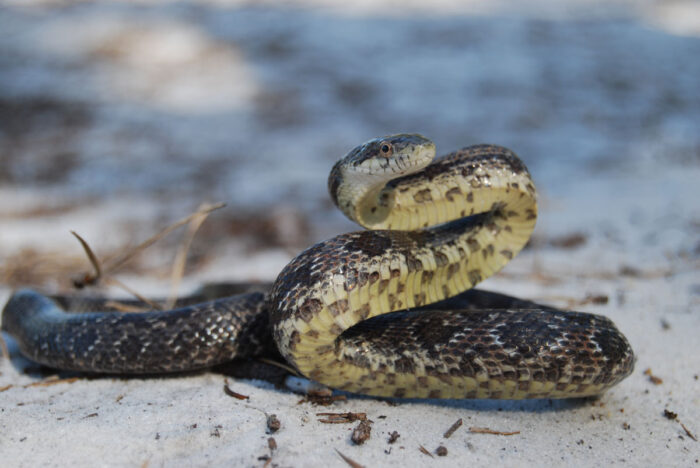Snakes
About 20 species of snakes inhabit the Pinelands, and several of these populations are quite remarkable. The timber rattlesnake is the only venomous species in the Pinelands and exists here as a disjunct population. Having been extirpated from the immediate environs of the Pinelands, they have managed to survive in about seven reproducing populations scattered through the region. The closest neighboring populations are in far north Jersey. The northern pine snake populations of the Pinelands are also cut off from their own kind. Northern Pine Snakes are not found again until you get all the way down to Virginia and West Virginia. Similarly, the Pinelands hosts the northernmost population of the corn snake. The most common snake of the Pinelands may be the northern water snake. Surely the most bizarre snake of the area is the eastern hognose, also known as the puff adder, since it often spreads its neck, cobra-like, when alarmed.
Read our blog post Summer and Reptiles in the Pines.
Black Rat Snake
Elaphe obsolete

Size: 42″ – 72″
Description: Constrictor. Feeds on frogs, lizards, small snakes, birds and eggs. Good climber of trees. Locally common in the Pine Barrens.
Corn Snake
Elaphe guttata

Size: 30″ – 48″
Description: Constrictor. Feeds largely on mice and rats, also birds and small rabbits. A good climber, but mostly terrestrial. Spends much time in rodent burrows. Only found in Burlington, Cumberland and Ocean Counties. State Endangered.
Eastern Hognose Snake
Heterodon platyrhinos

Size: 18″ – 30″
Description: Has a habit of playing dead when attacked or disturbed. May flatten its head and neck, hiss, and inflate body with air. If not successful, may flip onto back open, its mouth and play dead. Feeds mainly on frogs and toads. Found in woods, sandly plains, open fields, and edges of swamps. Common in the Pine Barrens.
Eastern King Snake
Lampropeltis getulus

Size: 36″ – 48″
Description: A strong constrictor. Feeds largely on other snakes but also on lizards, birds and rodents. Prefers stream banks and borders of swamps. Common in the Pine Barrens.
Eastern Ribbon Snake
Thamnophis sauritus

Northern Black Racer
Coluber constrictor

Size: 36″ – 60″
Description: Feeds on insects, frogs, rodents, small birds and eggs. A good climber but mostly terrestrial. Prefers open dry country and open fields. Locally common in the Pine Barrens.
Northern Pine Snake
Pituophis melanoleucus

Size: 48″ – 66″
Description: Constrictor. Feeds on rodents and birds and their eggs. One of the few snakes that excavates its own nesting burrow in open, sandly fields. Found in flat, dry, sandy pine country. Locally common in the Pine Barrens, but threated throughout the state of New Jersey.
Status: State Threatened
Northern Water Snake
Natrix sipedon

Size: 24″ – 42″
Description: Has a quick temper and readily bites but is not poisonous. Feeds mainly on small fish and frogs. Bears live young. Only large water snake of the Pine Barrens. Often seen sunning itself along edges of ponds or streams. Common in the Pine Barrens.
Rough Green Snake
Opheodrys aesrivus

Size: 22″ – 32″
Description: Feeds almost exclusively on spiders and insects like grasshoppers and caterpillars. Good climber and commonly moves about in bushes and low trees. Common in Pine Barrens.
Timber Rattlesnake
Crotalus horridus

Size: 36″ – 54″
Description: The only venomous snake found in the Pine Barrens. Feeds exclusively on warmblooded prey including shrews, moles, other rodents, rabbits and birds. Prefers second-growth timberlands where rodents are common. Becoming scarce in the Pine Barrens.
Status: State Endangered
Common Snapping Turtle
Chelydra serpentine

Size: 8″ – 18″
Description: Has a fighting disposition. Omnivorous: will feed on fish, frogs, young waterfowl and small animals, but also aquatic vegetation. Can reach ages 60-75 years. Habitat is any permanent body of water. Common in the Pine Barrens.
Eastern Box Turtle
Terrapene Carolina

Size: 4 1/2″ – 6″
Description: Basically a terrestrial turtle. Omnivorous: feeds on worms and insects, and foliage and fruit. Common in the Pine Barrens.
Eastern Mud Turtle
Kinosternon subrubrum

Size: 3″ – 4″
Description: A bottom feeder. Inhabits ponds, bogs and small lakes. Numerous in the Pine Barrens.
Eastern Painted Turtle
Chrysemys picta

Size: 4 1/2 ” – 6″
Description: Feeds on both plant and animal matter, including worms, larvae, snails, salamanders, and small fish. Often seen sunning itself on logs. Found in lakes, streams, shallow ponds, and marshes. Common in the Pine Barrens.
Musk Turtle
Sternotherus odoratus

Size: 3″ – 4 1/2″
Description: Also called a “stinkpot” for musky secretion emitted from glandular openings. A bottom feeder on smallliving organisms, and scavenger on dead animal matter. Common in ponds, quiet streams, and bogs throughout the Pine Barrens.
Red-bellied Turtle
Chrysemys rubriventris

Size: 10″ – 13″
Description: Feeds mostly on aquatic vegetation, plus some animals (worms, insect larvae, and small fish). Found in ponds, rivers, and larger bodies of water. Common in the Pine Barrens.
Northern Fence Lizard
Sceloporus undulatus hyacinthinus

Size: 4″ – 7″
Description: Feeds largely on flies and other small insects. Seen running on sand or in stumps, logs, or fences. Common in the Pine Barrens.